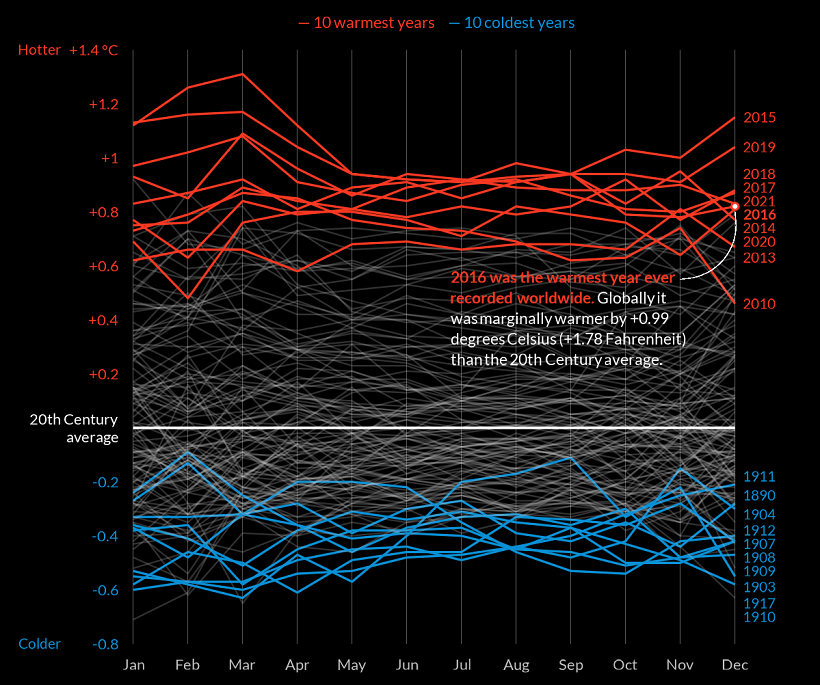ENVIRONMENTAnimation: Visualizing 140 Years of Global Surface TemperaturesPublished 1 day ago on September 23, 2022
By Pablo Alvarez green checkmark iconFeatured Creator
Article/Editing:
Carmen Ang
Tweet
Share
Share
Reddit
Email
Average surface temperatures since 1800
Animated: 140 Years of Global Surface Temperatures
For hundreds of years, Earth’s average surface temperature has been steadily increasing. And over the last decade, this global heating appears to have intensified.
Since 1880, the global average temperature has risen by an average of 0.08°C (0.14°F) every 10 years, according to the National Oceanic and Atmospheric Administration (NOAA).
But since 1981, warming has been occurring at more than twice that rate, by about 0.18°C (0.32°F) per decade.
This graphic by Pablo Alvarez shows 140 years of global surface temperatures, highlighting the 10 coldest and warmest years from 1880-2021 using data from NOAA.
Global Surface Temperatures Over Time
Over the last century and a half, there have been fluctuations in global surface temperatures, with some of the coolest years on record occurring in the late 19th century and early 20th century.
Average surface temperature since 1800
However, the last two decades have seen unprecedented warming, with the 10 warmest years on record all occurring within the last 20 years. Here’s a look at the 10 hottest years since 1800, and how they compared to the 20th century average:
The 10 Warmest Years
Rank Year Deviation from 20th Century Avg. (°C)
#1 2016 +0.99
#2 2020 +0.97
#3 2019 +0.94
#4 2015 +0.93
#5 2017 +0.9
#6 2018 +0.82
#7 2014 +0.74
#8 2010 +0.72
#9 2013 +0.67
#10 2005 +0.66
As of this article’s publication, the warmest year on record was 2016, when temperatures were +0.99°C (1.78°F) above the 20th century average. After 2016, the second warmest year was 2020, when surface temperatures reached +0.97°C (1.75°F) higher than the previous century’s average.
What Factors Impact Earth’s Climate?
There are a number of natural factors that influence global surface temperatures, including phenomena such as:
Volcanic activity
Changes in the Earth’s orbit
Shifts in ocean currents
However, scientists believe that our current rate of warming has been undoubtedly caused by human influence, especially because of our carbon and other greenhouse gas (GHG) emissions.
According to the most recent report by the Intergovernmental Panel on Climate Change (IPCC), “observed increases in well-mixed greenhouse gas (GHG) concentrations since around 1750 are unequivocally caused by human activities.”
In other words, while Earth’s surface temperature naturally fluctuates over the years, our actions have undoubtedly contributed to recent changes in Earth’s climate.
What Are The Consequences?
We’re already seeing the impact of this warming, as the world struggles with extreme climate events like droughts, heatwaves, floods, and an influx of wildfires in places like Europe, the United States, and Australia.
These extreme weather patterns could become the new normal if left unchecked, which is why companies and policymakers around the world are embarking on different solutions—from targeting net zero goals to implementing technological innovations that could reduce emissions.
green check mark icon
This article was published as a part of Visual Capitalist’s Creator Program, which features data-driven visuals from some of our favorite Creators around the world.
Subscribe to Visual Capitalist
Subscribe to our free newsletter and get your mind blown on a daily basis:
Your email address
Sign up
RELATED TOPICS:Climate ChangeGlobal WarmingCarbon EmissionsGlobal Surface TemperatureDroughtsExtreme WeatherEditors-ChoicePlanet EarthFloodsCLICK FOR COMMENTSYOU MAY ALSO LIKE
Mapped: Countries With the Highest Flood Risk
Explained: The Relationship Between Climate Change and Wildfires
5 Things to Know About Europe’s Scorching Heatwave
How Far Are We From Phasing Out Coal?
The World’s Loss of Forests Shareable
Visualizing the World’s Loss of Forests Since the Ice-Age
The Future of Global Coal Production (2021-2024F)
WATERMapped: Countries With the Highest Flood Risk
Recent floods in Pakistan have affected more than 33 million people. Where is the risk of flooding highest around the world?
Published 1 week ago on September 14, 2022
By
Niccolo Conte
Risk of Flooding Mapped Around the World
This was originally posted on Elements. Sign up to the free mailing list to get beautiful visualizations on natural resource megatrends in your email every week.
Devastating floods across Pakistan this summer have resulted in more than 1,400 lives lost and one-third of the country being under water.
This raises the question: which nations and their populations are the most vulnerable to the risk of flooding around the world?
Using data from a recent study published in Nature, this graphic maps flood risk around the world, highlighting the 1.81 billion people directly exposed to 1-in-100 year floods. The methodology takes into account potential risks from both inland and coastal flooding.
Asian Countries Most at Risk from Rising Water Levels
Not surprisingly, countries with considerable coastlines, river systems, and flatlands find themselves with high percentages of their population at risk.
The Netherlands and Bangladesh are the only two nations in the world to have more than half of their population at risk due to flooding, at 59% and 58%, respectively. Vietnam (46%), Egypt (41%), and Myanmar (40%) round out the rest of the top five nations.
Besides the Netherlands, only two other European nations are in the top 20 nations by percentage of population at risk, Austria (18th at 29%) and Albania (20th at 28%).
Rank Country Flood risk, by population exposed (%) Total population exposed
#1 
#2 
#3 
#4 
#5 
#6 
#7 
#8 
#9 
#10 
#11 
#12 
#13 
#14 
#15 
#16 
#17 
#18 
#19 
#20 
#21 
#22 
#23 
#24 
#25 
The Southeast Asia region alone makes up more than two-thirds of the global population exposed to flooding risk at 1.24 billion people.
China and India account for 395 million and 390 million people, respectively, with both nations at the top in terms of the absolute number of people at risk of rising water levels. The rest of the top five countries by total population at risk are Bangladesh (94 million people at risk), Indonesia (76 million people at risk), and Pakistan (72 million people at risk).
How Flooding is Already Affecting Countries Like Pakistan
While forecasted climate and natural disasters can often take years to manifest, flooding affected more than 100 million people in 2021. Recent summer floods in Pakistan have continued the trend in 2022.
With 31% of its population (72 million people) at risk of flooding, Pakistan is particularly vulnerable to floods.
In 2010, floods in Pakistan were estimated to have affected more than 18 million people. The recent floods, which started in June, are estimated to have affected more than 33 million people as more than one-third of the country is submerged underwater.
The Cost of Floods Today and in the Future
Although the rising human toll is by far the biggest concern that floods present, they also bring with them massive economic costs. Last year, droughts, floods, and storms caused economic losses totaling $224.2 billion worldwide, nearly doubling the 2001-2020 annual average of $117.8 billion.
A recent report forecasted that water risk (caused by droughts, floods, and storms) could eat up $5.6 trillion of global GDP by 2050, with floods projected to account for 36% of these direct losses.
As both human and economic losses caused by floods continue to mount, nations around the world will need to focus on preventative infrastructure and restorative solutions for ecosystems and communities already affected and most at risk of flooding.
CONTINUE READINGMISCAll the Contents of the Universe, in One Graphic
We explore the ultimate frontier: the composition of the entire known universe, some of which are still being investigated today.
Published 1 month ago on August 19, 2022
By
Mark Belan
The Composition of the Universe
All the Contents of the Universe, in One Graphic
Scientists agree that the universe consists of three distinct parts: everyday visible (or measurable) matter, and two theoretical components called dark matter and dark energy.
These last two are theoretical because they have yet to be directly measured—but even without a full understanding of these mysterious pieces to the puzzle, scientists can infer that the universe’s composition can be broken down as follows:
Component Value
Dark energy 68%
Dark matter 27%
Free hydrogen and helium 4%
Stars 0.5%
Neutrinos 0.3%
Heavy elements 0.03%
Let’s look at each component in more detail.
Dark Energy
Dark energy is the theoretical substance that counteracts gravity and causes the rapid expansion of the universe. It is the largest part of the universe’s composition, permeating every corner of the cosmos and dictating how it behaves and how it will eventually end.
Dark Matter
Dark matter, on the other hand, has a restrictive force that works closely alongside gravity. It is a sort of “cosmic cement” responsible for holding the universe together. Despite avoiding direct measurement and remaining a mystery, scientists believe it makes up the second largest component of the universe.
Free Hydrogen and Helium
Free hydrogen and helium are elements that are free-floating in space. Despite being the lightest and most abundant elements in the universe, they make up roughly 4% of its total composition.
Stars, Neutrinos, and Heavy Elements
All other hydrogen and helium particles that are not free-floating in space exist in stars.
Stars are one of the most populous things we can see when we look up at the night sky, but they make up less than one percent—roughly 0.5%—of the cosmos.
Neutrinos are subatomic particles that are similar to electrons, but they are nearly weightless and carry no electrical charge. Although they erupt out of every nuclear reaction, they account for roughly 0.3% of the universe.
Heavy elements are all other elements aside from hydrogen and helium.
Elements form in a process called nucleosynthesis, which takes places within stars throughout their lifetimes and during their explosive deaths. Almost everything we see in our material universe is made up of these heavy elements, yet they make up the smallest portion of the universe: a measly 0.03%.
How Do We Measure the Universe?
In 2009, the European Space Agency (ESA) launched a space observatory called Planck to study the properties of the universe as a whole.
Its main task was to measure the afterglow of the explosive Big Bang that originated the universe 13.8 billion years ago. This afterglow is a special type of radiation called cosmic microwave background radiation (CMBR).
Temperature can tell scientists much about what exists in outer space. When investigating the “microwave sky”, researchers look for fluctuations (called anisotropy) in the temperature of CMBR. Instruments like Planck help reveal the extent of irregularities in CMBR’s temperature, and inform us of different components that make up the universe.
You can see below how the clarity of CMBR changes over time with multiple space missions and more sophisticated instrumentation.
CMBR Instruments
What Else is Out There?
Scientists are still working to understand the properties that make up dark energy and dark matter.
NASA is currently planning a 2027 launch of the Nancy Grace Roman Space Telescope, an infrared telescope that will hopefully help us in measuring the effects of dark energy and dark matter for the first time.
As for what’s beyond the universe? Scientists aren’t sure.
There are hypotheses that there may be a larger “super universe” that contains us, or we may be a part of one “island” universe set apart from other island multiverses. Unfortunately we aren’t able to measure anything that far yet. Unravelling the mysteries of the deep cosmos, at least for now, remains a local endeavor.
CONTINUE READING
SUBSCRIBE
Join the 300,000+ subscribers who receive our daily email
Your email address
Sign Up






























